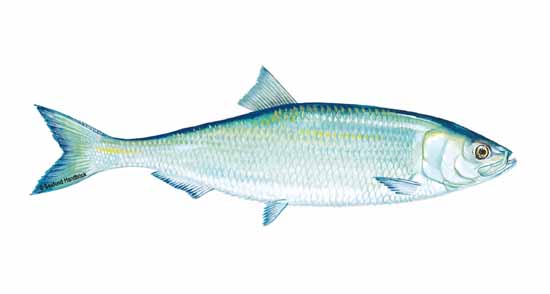Herring
Published on
January 23, 2014

The humble herring once determined the fate of kings and empires. The powerful Hanseatic League of Germany and Scandinavia collapsed in the 15th century when herring stopped spawning in the Baltic Sea. Treaties worth millions of dollars were negotiated for herring rights in the New World. But, in America, herring was strictly a food of the laboring class for several decades, starting with the Boston Irish in the 1880s. The American palate is most accustomed to herring as canned sardines. There are two types of commercially important herring. Atlantic herring (Clupea harengus harengus) is found across the North Atlantic; Pacific herring (C. harengus pallasi) range from northern California to Alaska and from eastern Russia south to Japan. Herring is gillnetted, seined and caught with midwater trawls. The fish is also trapped in shore-based weirs in New Brunswick, Canada and Maine. Market size is 5 to 9 inches.
Clupea harengus
Herring
Atlantic herring, Pacific herring, sardine
Hareng
Hering
Aringa
Nishin
Arenque
The humble herring once determined the fate of kings and empires. The powerful Hanseatic League of Germany and Scandinavia collapsed in the 15th century when herring stopped spawning in the Baltic Sea. Treaties worth millions of dollars were negotiated for herring rights in the New World. But, in America, herring was strictly a food of the laboring class for several decades, starting with the Boston Irish in the 1880s. The American palate is most accustomed to herring as canned sardines. There are two types of commercially important herring. Atlantic herring (Clupea harengus harengus) is found across the North Atlantic; Pacific herring (C. harengus pallasi) range from northern California to Alaska and from eastern Russia south to Japan. Herring is gillnetted, seined and caught with midwater trawls. The fish is also trapped in shore-based weirs in New Brunswick, Canada and Maine. Market size is 5 to 9 inches.
Fresh herring ranges from delicately flavored small fish to larger fish with a fuller, “oilier” flavor. Otherwise, flavor and texture depend on how the herring has been prepared — whether pickled, smoked or salted.Fresh, whole herring should be bright with hard bellies. Scales are large, loosely attached and cover the entire body. The meat of fresh herring is off-white and soft; sardines range from light to dark brown, with small bones visible; kippers are clear, light meat without bones.
| Calories: | 158 |
| Fat Calories: | 81 |
| Total Fat: | 9.0 g |
| Saturated Fat: | 2.0 g |
| Cholesterol: | 60 mg |
| Sodium: | 90 mg |
| Protein: | 17.9 g |
| Omega 3: | 1.6 g |
Though fresh herring can be cooked in nearly any fashion except poaching or steaming, it’s rare to find well-handled fresh product in the United States. Most of the herring eaten here is in canned, pickled or smoked form. Because of the high oil content, herring is a good candidate for smoking, and the fish’s soft meat firms up if pickled in brine. The Scots fry fresh herring, rolling it in coarse oatmeal first.
Bluefish, Mackerel
- Bake
- Boil
- Broil
- Fry
- Grill
- Pate
- Poach
- Saute
- Smoke
- Steam
Fresh: Whole, Fillets
Frozen: Whole, Fillets
Value-added: Canned, Smoked, Pickled, Salted
Canada, Iceland, Japan, Norway, Russia, UK, United States






